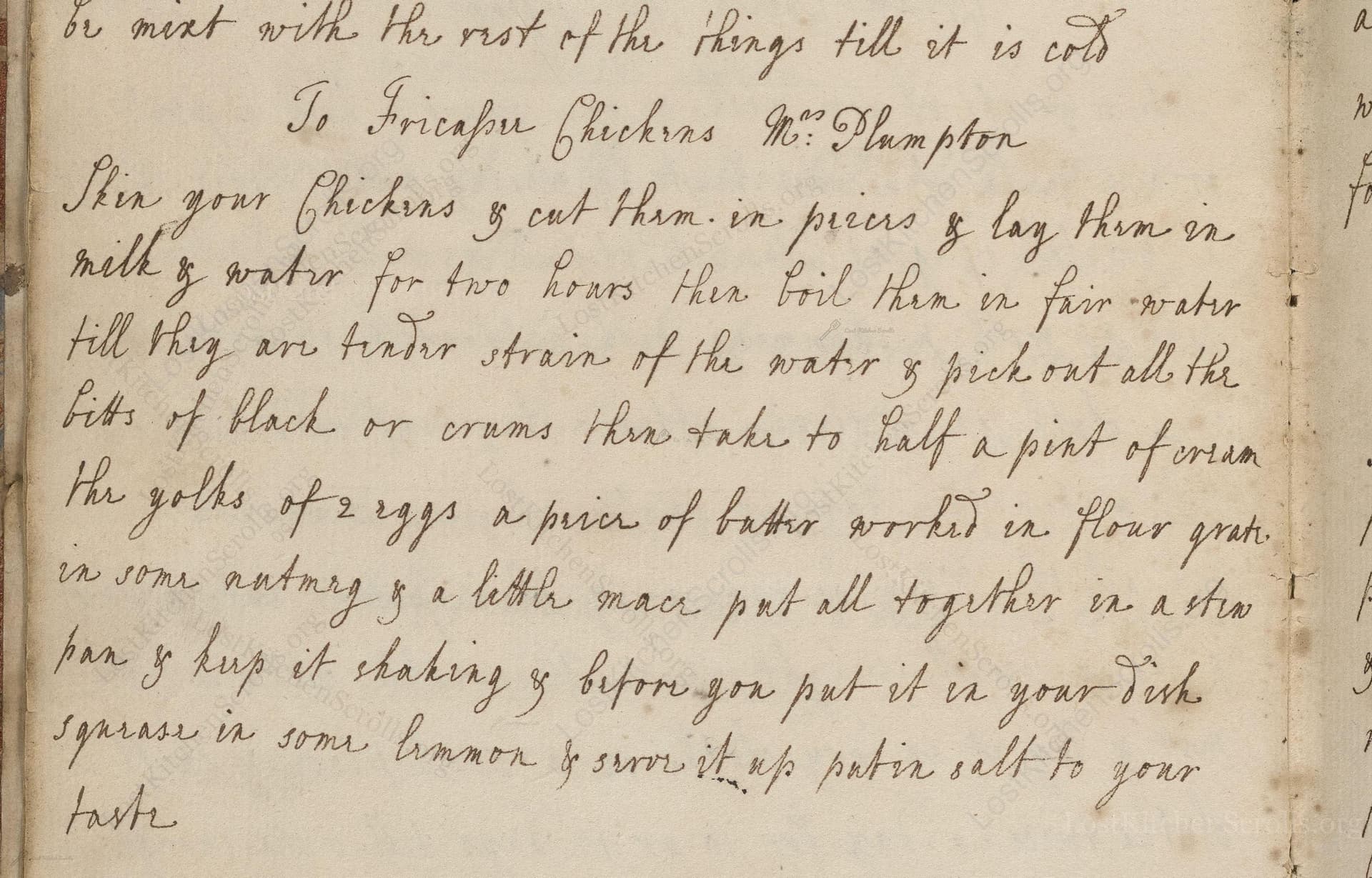To Fricasee Chickens Mr: Plumpton
From the treasured pages of Cookbook of Elizabeth Langley
Written by Elizabeth Langley

To Fricasee Chickens Mr: Plumpton
"Skin your Chickens & cut them in pieces & lay them in milk & water for two hours then boil them in fair water till they are tender strain of the water & pick out all the bitts of black or crams then take to half a pint of cream the yolks of 2 eggs a piece of butterr worked in flour grate in some nutmeg & a little mace put all together in a stew pan & keep it shaking & before you put it in your dish squarase in some lemmon & swen it up put in salt to your taste"
Note on the Original Text
This recipe is written in the characteristically fluid, minimal style of 18th-century English manuscripts: no ingredient lists, vague measurements ('a piece of butter'), and a focus on method over precision. Spelling reflects either phonetic rendering or period norms, hence 'squarase' for 'squeeze', and 'swene' (likely 'swing', i.e., mix in). The recipe assumes a competent cook who could interpret these cues, and who measured by eye and taste as much as by any standard units. Instructions like 'work in flour' refer to rubbing butter and flour together—now a common thickening technique.

Title
Cookbook of Elizabeth Langley (1757)
You can also click the book image above to peruse the original tome
Writer
Elizabeth Langley
Era
1757
Publisher
Unknown
Background
Step into the Georgian kitchen with Elizabeth Langley's 1757 culinary collection, where refined techniques and delightful recipes await those with a taste for historic gastronomy.
Kindly made available by
Folger Shakespeare Library
This recipe is attributed to Elizabeth Langley, writing in 1757, a period when fricassee dishes were the epitome of refined British cookery—light, creamy, and designed to showcase delicate poultry. The method reflects a transition from the robust, spice-laden fare of earlier centuries to the lighter, subtler aristocratic tastes of mid-18th-century England. Household cookbooks of this era, often compiled by or for women like Mrs. Langley, were passed among family and friends, preserving both recipes and domestic wisdom. The reference to soaking chicken and clarifying the stock shows an increasing focus on elegant presentation and subtlety of flavour.

In the mid-18th century, cooks would have used a large iron or copper stewpan or pot for boiling the chicken, wooden spoons for stirring, and perhaps a pestle and mortar to grind spices like nutmeg and mace. To separate the yolks and beat the butter and flour together, they may have relied on simple bowls and a fork or whisk made from twigs. Lemon was squeezed by hand, and cream would be fresh from the dairy. The 'stew pan' was essential—its heavy base allowed gentle simmering for delicate sauces, and shaking the pan ('keep it shaking') prevented sticking or curdling.
Prep Time
15 mins
Cook Time
45 mins
Servings
6
We've done our best to adapt this historical recipe for modern kitchens, but some details may still need refinement. We warmly welcome feedback from fellow cooks and culinary historians — your insights support the entire community!
Ingredients
- 3 1/3 lbs chicken pieces, skinned
- 2 cups whole milk
- 4 1/4 cups water
- 1 cup heavy cream
- 2 large egg yolks
- 2 tablespoons (1 oz) unsalted butter
- 1 tablespoon (about 1/4 oz) plain flour
- 1/4 teaspoon grated nutmeg
- 1/8 teaspoon ground mace
- Juice of 1/2 lemon
- Salt, to taste
Instructions
- Begin by skinning approximately 3 1/3 pounds of chicken pieces (such as thighs, drumsticks, or a cut-up whole chicken).
- Soak these pieces in a mixture of 2 cups milk and 4 1/4 cups water for 2 hours in the refrigerator.
- Drain and rinse the chicken, then place it in a large pot and cover with cold water.
- Bring to a gentle boil and simmer until the meat is tender, about 30-40 minutes, skimming off any impurities.
- Drain the chicken and remove any dark bits or residual scraps.
- In a saucepan, combine 1 cup heavy cream, the yolks of 2 eggs, 2 tablespoons (1 ounce) unsalted butter worked with 1 tablespoon (about 1/4 ounce) of flour, a generous grating of nutmeg, and a pinch of ground mace.
- Heat gently and stir continuously, keeping the sauce smooth.
- Add the cooked chicken pieces to this sauce, shaking or stirring to coat and warm through.
- Just before serving, squeeze in the juice of half a lemon and season to taste with salt.
- Serve hot.
Estimated Calories
520 per serving
Cooking Estimates
Preparation takes about 15 minutes for skinning the chicken and mixing the soak, plus a 2-hour soak time. Cooking the chicken and preparing the sauce take about 45 minutes more. Each serving contains about 520 calories.
As noted above, we have made our best effort to translate and adapt this historical recipe for modern kitchens, taking into account ingredients nowadays, cooking techniques, measurements, and so on. However, historical recipes often contain assumptions that require interpretation.
We'd love for anyone to help improve these adaptations. Community contributions are highly welcome. If you have suggestions, corrections, or cooking tips based on your experience with this recipe, please share them below.
Join the Discussion
Rate This Recipe

Den Bockfisch In Einer Fleisch Suppen Zu Kochen
This recipe hails from a German manuscript cookbook compiled in 1696, a time whe...

Die Grieß Nudlen Zumachen
This recipe comes from a rather mysterious manuscript cookbook, penned anonymous...

Ein Boudain
This recipe comes from an anonymous German-language manuscript cookbook from 169...

Ein Gesaltzen Citroni
This recipe, dating from 1696, comes from an extensive anonymous German cookbook...
Browse our complete collection of time-honored recipes



